Coronavirus Ravaged New York's Budget and Made Your Census Participation More Important Than Ever
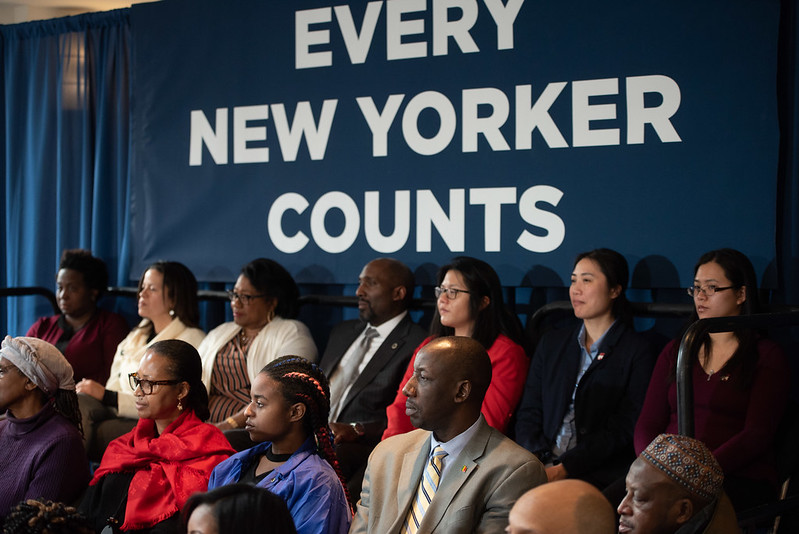
New York City Census efforts (photo: Michael Appleton/Mayoral Photography Office)
As the cost to confront COVID-19 grows each day, a severe fiscal fallout for New York’s state and city budgets becomes more of a certainty. And with steep cuts to government programs all but assured, we New Yorkers cannot overlook the significance of participating in this year’s Census. Consider this: New York’s recovery will depend on federal funding, and each person not counted can cost New York $3,054 critical to providing education, housing, transportation, and medical services in areas hit hard by COVID-19.
If New York City has the same low response rate that it did in 2010, it is likely that nearly 2.5 million people in New York City will not be counted in the self-response phase. This would equate to nearly $8 billion in lost federal funding, which happens to be about the projected shortfall in the city budget for this and next fiscal years. Representation in Congress is on the line, too. Because of a low count last Census, New York lost two seats in the House of Representatives.
With federal funding and equitable political representation critical to our recovery, the stakes of the Census couldn’t be higher. It is imperative that New Yorkers, especially those from historically undercounted immigrant and underserved communities, respond to the decennial count in droves. At the same time, the pandemic will make it even harder for some in these communities to participate.
As CEO of RiseBoro Community Partnership, a nonprofit that offers holistic services to meet community needs in Brooklyn, I know how structural racism and poverty often lead to marginalization. Brooklyn is notoriously the hardest-to-count county in all of New York. In the 2010 Census, Brooklyn had the lowest mail return rate in the country among counties with populations over 500,000. Approximately 80% of Brooklynites live in hard-to-count neighborhoods. 2020 is the year to buck that trend and ensure that low-income communities and people of color get fully counted.
States with the greatest number of people and highest concentrations of poverty receive proportionally greater amounts of federal aid than other states. Over 14% of the 19.5 million people living in New York State are below the poverty line. If underserved groups are not accurately represented in the Census, organizations like RiseBoro have a difficult time meeting the needs that exist in the communities they serve because of a lack of funding.
My organization is working in partnership with the City University of New York (CUNY), the mayor’s Census office, and the New York City Council to mobilize New Yorkers to self-respond to the 2020 Census. We received $250,000 to support a fair and complete count of Bushwick, Brownsville, and Crown Heights—three communities with poverty levels up to 40%.
The barriers to responding to the Census that these underserved communities faced in 2010 still exist today. There is limited English literacy; there are motives for concealment, such as undocumented status; and children under five and seniors are often undercounted. Brooklyn has the largest population of seniors and children under five in New York City.
Like most of the five boroughs, Brooklyn is a melting pot of cultures, and that is particularly true in Bushwick, Brownsville, and Crown Heights. In these communities the most common languages other than English are Spanish, Mandarin, and Cantonese. Residents typically rely on places like libraries and community centers to fill out the Census. With COVID-19 making that impossible, it’s up to community organizations to take the lead.
At RiseBoro, staff fluent in these languages are making calls to help people fill out their forms. With many in these communities concerned about their immigration status, being able to speak with someone in their own language is a way to put them at ease.
About 400,000 Brooklynites—15% of our borough’s total population—are not U.S. citizens. To every immigrant and person from an underserved community reading this, know that you are in no way in jeopardy of being deported because of your Census answers. Despite previous efforts by the Trump Administration, the 2020 Census contains no question about citizenship status.
Your response is vital to providing resources to you, your family, and your community. The Census results will inform how federal funding is allocated to programs you and other New Yorkers depend on, including Medicaid, community mental health services, and the Supplemental Nutrition Assistance Program (SNAP).
As a city, we need to put extra effort into responding to the Census. We are fighting for our share of over $650 billion a year that the federal government allocates, and with the coronavirus decimating New York’s budget, every person counts.
***
Scott Short is the CEO of RiseBoro Community Partnership, a nonprofit dedicated to holistic community revitalization in New York City. On Twitter @RiseboroNYC.
***
Have an op-ed idea or submission for Gotham Gazette? Email This email address is being protected from spambots. You need JavaScript enabled to view it.
Ensuring Domestic Violence Survivors Have the Resources They Need
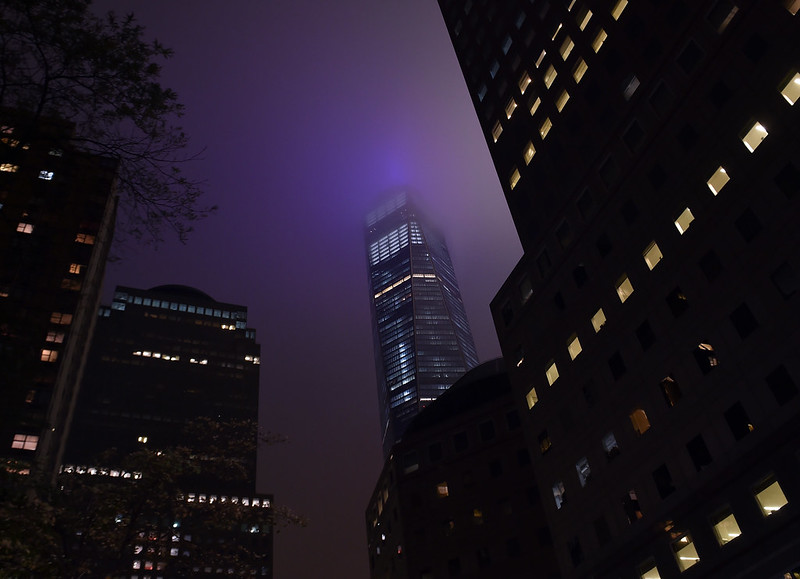
Purple lights for domestic violence awareness (photo: Kevin P. Coughlin/Governor's Office)
Over the past three months, our lives have come to depend almost entirely on technology. Canceled your wedding? Get married on Zoom! Want to introduce a new baby to the family? FaceTime them. Technology has allowed us to stay virtually connected when we are more physically disconnected than ever due to COVID-19.
But for domestic violence survivors, technology can be a double-edged sword. It can connect them to help, but it can also become a dangerous tool in the hands of their abuser.
As with everything else, the New York City Family Courts have gone almost entirely virtual. Emergency filings, like for an Order of Protection, are now done by email and cases are heard over the phone. But instructions on where and how to file change frequently, are not publicly available, and are confusing even for attorneys like myself. If you can figure out how to file, emergency petitions require consistent telephone and often internet access: Survivors spend potentially hours on the computer writing their petition, on the phone with an attorney, waiting for the court to call their case, and being heard by the judge.
Accessing those resources—time, space, internet, phone—is exceedingly complex for survivors who are still living with their abusers. Understanding this dilemma, the New York State Office for the Prevention of Domestic Violence unveiled a new chat service, which allows survivors to text 24/7 with domestic violence specialists. This might help connect people with other services and inform them about their rights, but it still assumes access to reliable internet or phone service and that the survivor’s phone is not being monitored by their abuser.
The circumstances can be even worse for survivors with limited means, and according to the National Network to End Domestic Violence, economic abuse occurs in 99% of domestic violence cases. The number of people experiencing poverty is also likely to grow as we face what the International Monetary Fund is predicting will be the worst economic downturn since the Great Depression.
Indeed, despite indications that domestic violence is on the rise, many organizations, including the New York Legal Assistance Group (NYLAG), where I am a Staff Attorney, have experienced a paradoxical decrease in hotline calls and cases. In Queens, the New York Times reported that domestic violence arrests have fallen nearly 40 percent. Why? While data is scarce, our experience suggests that this is because the few resources that are still available for abuse survivors are difficult if not impossible for those living with their abusers and/or in poverty to access.
Instead of accepting this as the status quo, we need to build a system that actually works for survivors—both for the duration of this crisis and for the next one.
I suggest a two-pronged approach. First, to truly keep survivors safe, everyone needs access to free basic internet, free basic cell phone services, and free mental health services. These are lifelines. The tragic truth is that domestic violence too often leads to death. Survivors need to be able to call not only 911 and 311, but the courts, the Family Justice Centers, and legal service providers like NYLAG. They need to be able to make these phone calls even when their abuser cuts them off financially. Even when they are experiencing poverty and can’t pay their phone or internet bill.
Research indicates that financial abuse occurs in 99% of domestic violence cases. Abusers often cut off their partner’s access to essential resources--like money, phone, and internet--in moments when they feel their partner is most likely to seek help. If everyone has access to free phone and internet, no one is dependent on an abusive partner to contact the courts, attorneys, or social workers.
But providing these basic services does not solve the entire problem because it still excludes those who are living with their abusers and those whose abusers are monitoring their devices. We also need to engage with people in the spaces we all still inhabit.
Most of us still go to grocery stores, bodegas, pharmacies, hardware stores, banks, and hospitals. Signs in the predominant languages of each neighborhood could be posted with instructions on how to access these resources. Staff in these places could be trained to provide information to those who need it. Police precincts could provide safe, clean spaces for survivors to take phone calls with their attorneys or the courts.
Now is the time to enact these changes to ensure that every resident of our city has a basic safety net under both ordinary and extraordinary circumstances.
***
Micah Horwitz, Esq. is a staff attorney in the New York Legal Assistance Group’s Domestic Violence Law Unit.
***
Have an op-ed idea or submission for Gotham Gazette? Email This email address is being protected from spambots. You need JavaScript enabled to view it.
Democratic Voters are Electing Presidential Delegates; Here’s How It Works and What It Means
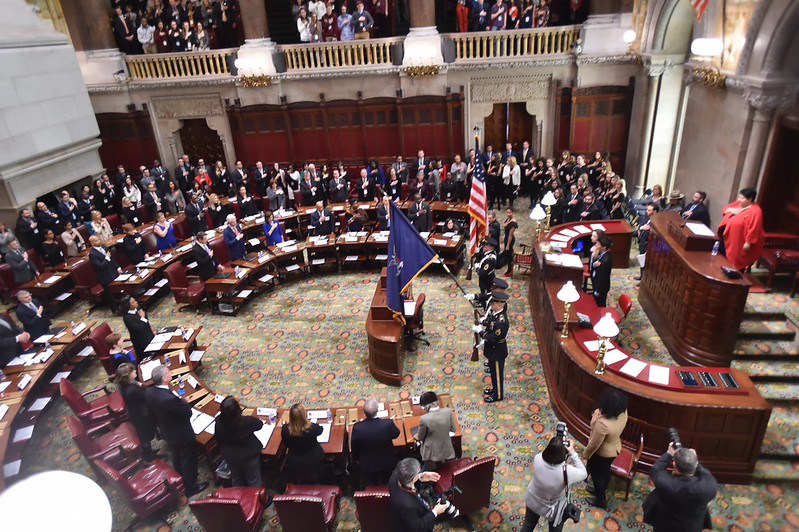
Electors voting in Albany in 2016 (photo: Kevin P. Coughlin/Governor's Office)
The Presidential Primary is complicated. As New York State’s failed attempt to cancel it shows, there’s more at stake than just the Democratic nominee. Instead, hundreds of delegates are running around the country in their own right to give their communities a seat at the table.
So, what do delegates do? And why, in New York, can you vote for presidential candidates and delegates separately?
Selecting the Party nominee for President
When you vote for the Democratic nominee in the Presidential Primary, you are not actually voting for a candidate. You are voting for what proportion of delegates they should get from your district.
In New York, your Delegate District is your Congressional District (CD). Every district gets a certain number of delegates based on a formula (that I won’t go into now). When you vote for a presidential candidate, you are voting for what percentage of the delegates they get. If they get 35% percent of the vote in the district, they get 35% of the delegates. Those delegates go to the national convention.
Since, in theory, a candidate could win 100% of the vote, most run more delegates -- a slate -- than will be able to attend the convention.
That’s where voting for delegates comes in...
Regardless of your presidential candidate vote, you can separately vote for any delegate you want — even if they support a different candidate. Regardless of how many votes a presidential candidate gets, the order of delegates who will get to attend the national convention with them is based on how many votes the individual delegates receive.
So, if your Congressional District gets 100 delegates to the national convention, and Candidate A gets 50% of the primary vote, that candidate gets 50 delegates from your district to the convention. But how does the candidate choose which 50 from their slate have the honor? Whichever delegates get the most votes.
As a result, if you support Joe Biden, but your friend supports Bernie Sanders and is running to be a delegate to the convention, you can vote for Biden, to give him more New York delegates, but you can also vote for your friend, to make her more likely to BE a delegate among Sanders’ number.
There is one caveat, though. The delegate rolls alternate female-male. So the delegate list is the highest vote-getters, but it flips between the highest female vote-getter and the highest male-vote getter for each slot.
Delegates do More than Select the Nominee
If all delegates did was select the presidential nominee, cancelling the primary wouldn’t matter after everyone had dropped out and conceded to Biden. But that’s not the case.
Delegates are the actual representatives of registered party members to the national organization. They are responsible for ratifying or changing the Party Rules and the Party Platform. If you want to push an issue to the Party Platform, or change the Party Rules, you need a delegate who’s on board.
I wrote more explaining just how important the delegates are to the political process here, but suffice it to say, their independent role in Democratic Party and political governance is why New York State was court-ordered to proceed with the Presidential Primary.
In the end, these delegates are not merely presidential delegates, they are Democratic National Convention delegates — one of Democratic voters’ many representatives to your political party.
Remember, only registered Democrats can vote in the various Democratic primaries this month and for Presidential Delegates. To see who is running for Presidential Delegate in your Congressional District, enter your address here and follow the steps to find your sample ballot for the presidential primary (there are two spots for sample ballots on the page, as well as poll-site info for early voting and primary day).
***
Ben Yee is the Democratic State Committeeman for New York's 66th Assembly District and former Secretary of the Manhattan Democratic Party. On Twitter at @yben.
***
Have an op-ed idea or submission for Gotham Gazette? Email This email address is being protected from spambots. You need JavaScript enabled to view it.
Encouraging Trends to Embrace for Path Forward at City’s Specialized High Schools

Mayor and Chancellor have major decisions to make (photo: Ed Reed/Mayor's Office)
While our schools are shut down because of the coronavirus, recent good news points to successful efforts to improve the ethnic diversity of the city’s specialized high schools -- Brooklyn Tech, Stuyvesant, Bronx Science, and five others.
At the end of May, the New York City Department of Education issued its report on the Discovery Program. Created over 50 years ago to improve admissions for black and Latino students, it had fallen into complete disuse, except at Brooklyn Tech. To be eligible, students must score a bit below the cutoff on the specialized high school exam (SHSAT) and qualify under federal anti-poverty guidelines. Those who enter the Discovery Program take enhanced educational courses over the summer to better prepare them for the rigors of the specialized high school curriculum.
Several years ago, the Brooklyn Tech Alumni Foundation, which I head, advocated for the reintroduction of Discovery but with a tweak to admit more black and Latino students by focusing eligibility on underrepresented middle schools. Because Asian-American families in New York City have the highest poverty rate, only basing eligibility on economic status did not appreciably enter black and Latino students.
The number of Discovery seats this year is 800 compared to 250 in 2018. This year, 470 Discovery invitations went to black and Latino students, compared to only 278 last year. This is a significant increase over what existed before the Department of Education accepted our suggestion. Even more exciting, now there are first-time admissions from middle schools previously not represented among the student bodies of the specialized high schools.
While black and Latino Discovery admissions greatly increased, Schools Chancellor Richard Carranza poo-poos the achievement: He says revamped Discovery “does not move the needle enough,” which is classic Carranza. He refuses to say that anything short of eliminating the SHSAT is good enough, no matter how good.
For another example, he testified at the City Council that he disfavored expanding the city’s Dream test prep program, which also improves the specialized high school admission rates of black and Latino students. He said it “would not be a good use of resources,” although he blames private test prep for the demographic disparity in admissions.
Here again, Carranza is wrong. For the past six years, the Brooklyn Tech Alumni Foundation has run a pilot program combining focused outreach to underrepresented Brooklyn middle schools with two years of educational enrichment and free test prep. Sixty percent of participants were accepted at a specialized high school. Most were black, Latino, or female, another underrepresented group in our specialized schools.
The students from our first cohort are now attending Binghamton, Brown, CCNY, Cornell, Howard, Macaulay Honors, Middlebury, Northeastern, Rutgers, SUNY Buffalo, UCLA, and Michigan. This program should serve as a model for the city to roll out an effective affirmative action program based at each of the specialized schools.
Several years ago, the state allocated $1.75 million to the New York City DOE to launch similar programs at the specialized schools. At Tech, where we got a dedicated grant of $250,000, we doubled the size of our program. For the rest, the DOE did nothing.
Since arriving in New York, Carranza has repeatedly criticized the specialized high schools because the percentage of black and Latino students attending these schools is too low. He ignores that 20 years ago, the enrollment of black and Latino students at the specialized schools was much better. Back then, the Education Department had enhanced educational opportunities like gifted elementary programs and junior high SP classes in the schools serving heavily black and Latino communities.
Carranza should recognize that eliminating the test does nothing to improve the education in our schools for the children he wants to help. To restore equity in our specialized schools, he needs to improve the coursework offered in these communities while supporting innovative and successful efforts to promote diversity now. The models are here.
Our schools will eventually reopen, but it is now time for the Chancellor to recognize that he should lead, not criticize. He owes it to all the city’s children but especially to the students in the black and Latino communities.
***
Larry Cary is a Manhattan lawyer and the President of the Brooklyn Tech Alumni Foundation.
***
Have an op-ed idea or submission for Gotham Gazette? Email This email address is being protected from spambots. You need JavaScript enabled to view it.
Hurricane Season Could Delay COVID-19 Recovery: Here's How We Prepare
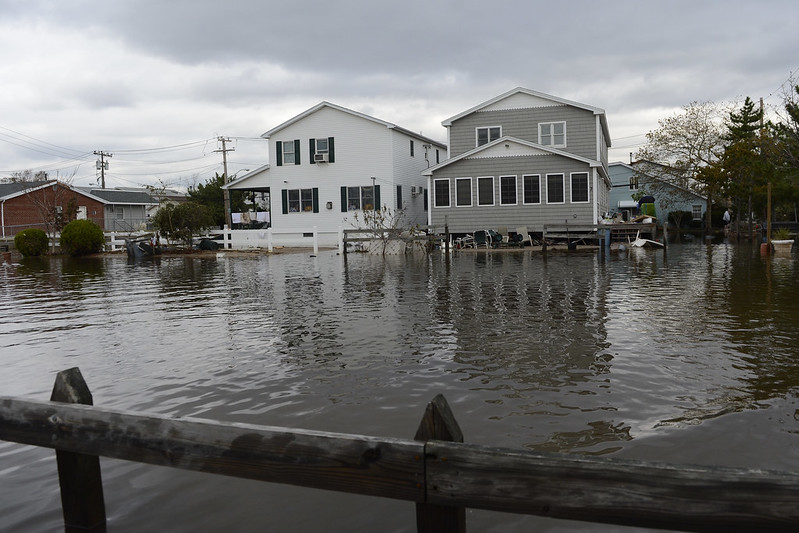
It's time to better prepare (photo: governor's office)
New York has faced its share of disasters, and each one seemed impossible and unprecedented until it actually happened. 9/11, Superstorm Sandy, and now COVID-19 each took a dramatic toll on our social and physical infrastructure, the state’s economy, and our very way of life.
We always recover, but we must break the cycle of rebuilding and plan for future risk instead. Any threats must be taken seriously as many communities are already overextended and strained. Hurricane season starts next month, and we need flood policy reforms at a federal level to ensure an already bad situation doesn't get worse.
The ongoing battle to contain COVID-19 coupled with the upcoming threat of hurricane season is a dangerous combination. Early forecasts indicate this Atlantic hurricane season may be worse than usual, which would have a devastating impact on our already fragile infrastructure. Flooding has massive and damaging impacts: from roads and public infrastructure to our homes to our workplaces. We saw this during Superstorm Sandy where New York’s infrastructure and economy took a massive hit. Sadly, our infrastructure is no better prepared now than it was then. When you factor in the consequences COVID-19 has already had on our state and sources of revenue, New York cannot handle another blow so soon.
Without comprehensive federal action to reduce flood risk, our current disaster relief and recovery policies will continue to allow and even incentivize risky development, leaving existing and future infrastructure and our communities in peril. As local businesses begin to reopen in a post-COVID world, we must ensure that they can remain open if a storm hits by investing in resilient infrastructure. Our small businesses rely on well-functioning infrastructure, and our community must advocate for an updated flood-ready requirement that is smart and forward-thinking. There are certain steps we and our policymakers must take that are critical to New York’s survival and recovery.
Support the 2020 Environmental Bond Act
First, we encourage New Yorkers to vote to approve the environmental bond act on the ballot for the general election this fall, which would be hugely advantageous for New York’s economy and environment. Despite facing challenges from COVID-19, Governor Cuomo and the Legislature advanced the bond act, known as the Restore Mother Nature Bond Act, which would provide $3 billion for a wide range of environmental protection programs and initiatives, including flood mitigation; habitat restoration; combating climate change; and clear water projects, while creating critical jobs.
Invest in Resilient Infrastructure
Our state’s economy is also directly tied to environmental resilience and sustainability. Every $1 invested in disaster mitigation saves $6 in flood damage costs. Our infrastructure across the state has trouble handling heavy rains, let alone massive storms, and in the current climate we must keep in mind that it is in our best economic interest to invest in a resilient foundation. By building or rebuilding with resilience in mind we can protect communities and save money.
Disclose a Property’s Flooding History
It is imperative to equip consumers with crucial information on properties they intend to buy or rent, like the property’s flooding history. If we make the disclosure of this information mandatory, people will be more prepared when making important and life-changing financial decisions, such as buying a house or renting an apartment, and therefore not be surprised by the massive financial upheaval that is caused if your living or working space is completely flooded. New Yorkers are having trouble making rent and mortgage payments now, and aren’t able to save up to fix property damage due to flooding.
Reform the NFIP
The National Flood Insurance Program (NFIP) is another key policy that helps protect our communities. However, it has not been updated to address locations that are flooding more frequently or are still handling damage from previous floods. The program remains $20 billion in debt. Congress must not only fund and reform the NFIP but invest in long-term resilience through FEMA’s Building Resilient Infrastructure and Communities program and the development of a revolving loan and grant program to fund risk reduction.
Through updates to NFIP, we can also promote and protect our existing ecological systems. Investing in nature-based solutions is crucial to encouraging flourishing wildlife while protecting our local communities.
All of these changes are economically smart and environmentally crucial, even more so as we begin to feel the aftershocks and recover from the total upheaval of COVID-19. We urge New York voters to approve the environmental bond act this fall and Congress to reform NFIP, protect our infrastructure and wildlife in New York, and provide a more stable economic pathway for the future.
***
Julie Tighe is President of the New York League of Conservation Voters, a nonpartisan, statewide environmental organization that fights for clean water, healthy air, renewable energy, and open space. On Twitter @JulieTighe17 & @NYLCV.
***
Have an op-ed idea or submission for Gotham Gazette? Email This email address is being protected from spambots. You need JavaScript enabled to view it.
Good News and Bad News on the State of Homelessness in New York City
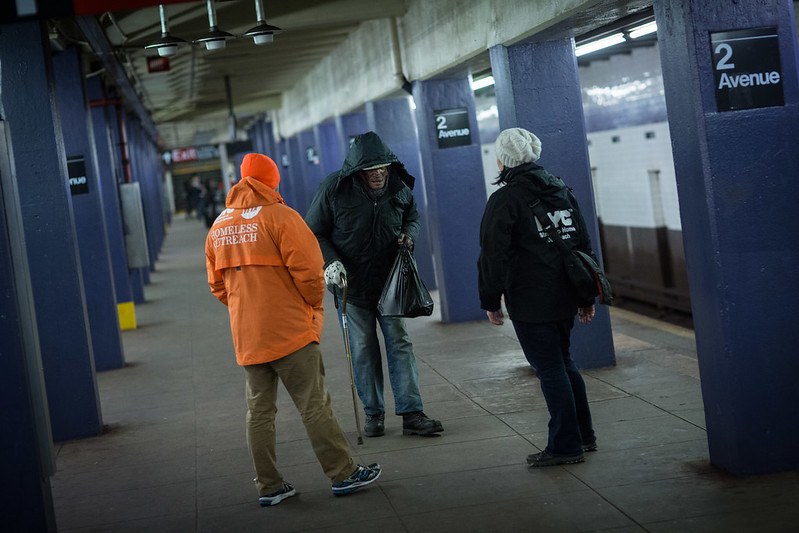
Homeless outreach workers approach a person in the subway (photo: Michael Appleton/Mayor's Office)
As the city has been focused on the coronavirus crisis the attention concerning homeless people has been the growing number of them in the subway system, it is time we examined what is happening within the vast and very expensive shelter system that is costing $2 billion a year.
As a former Deputy Commissioner with the New York City Department of Homeless Services I can tell you that there are three types of shelters. There is the single adult system, the adult family system, comprised of two adults without children, and the families with children system.
According to the latest report from the Department there are nearly 57,000 total individuals residing in the shelter system, 37,000 are adults and 20,000 are children.
There is some good news: the number of families with children is down 7% from the same time last year and over the past six years this number is nearly even (now: 11,250; then: 10,900). There is less good news in the adult family shelter system where we have 2,416 people residing now compared to 2,495 at the same time last year. While that number is down slightly from a year ago, the present number is 28% higher than it was six years ago.
And now for the bad news: the number of single adults presently residing in the shelters is 17,200 (12,700 men and 4,500 women). This number is up by 8% over last year at this time and up an incredible 70% in the last six years.
The city is spending an average of $125 a night to house single adults, but this number, which is already the result of a high number of clients residing in overflow hotel rooms, is growing rapidly. The expense will skyrocket after the city finishes paying for the additional 7,000 rooms it is now renting to stop the spread of the coronavirus, which might not have been necessary, to such an extent, if the shelter system was not so severely overcrowded. Individuals residing in congregate shelters are being moved to hotel rooms, often two to a room, in the effort to limit the spread.
If you are wondering why the single population is up by 70% over six years, during which time the city has had a very low unemployment rate, one of the reasons is that the state has been dumping 4,500 newly-released prisoners directly into the shelter system each year. This transfer of prisoners from the care of the state into city shelters must be curtailed immediately. The state must do a better job of discharge planning and establishing a large system of halfway houses.
The average length of stay for those in the single adult system is up significantly and so after the pandemic the city should consider going back to the Work Experience Program, where healthy clients would be required to do 20 hours a week of community service such as cleaning a public park or the grounds of a public housing development.
Another way to reduce the number of single adults in the shelter system is to set up an eligibility review process similar to the one used in the family system. New clients should be questioned as to whether they have any other alternative living arrangements and if so be denied entry, which is reserved for those who are without any other means of shelter. The Bloomberg administration attempted to do this some 10 years ago but the City Council shot it down. However, the times have certainly changed with this terrible virus and its fallout, whereby a million New Yorkers have or are estimated to lose their jobs, and city government is expecting a drop of roughly $9 billion in tax revenue between this fiscal year and next. As a result, Mayor de Blasio has talked about laying off essential city employees and slashing billions in city spending.
Another efficient and very effective way to reduce the homeless population in unacceptable shelter circumstances is to provide supportive housing to single adults who need it. I ran two supportive housing programs where shelter residents have an apartment with social services. Unfortunately, the city and state are at a 14-year-low on making such placements. The inability of Mayor de Blasio and Governor Cuomo to work together on a new “New York-New York agreement, like their predecessors did three times, has resulted in many units being promised but few actually funded and opened. In fact, ten years ago twice as many single adults living in shelters were placed into supportive housing as compared to now.
As COVID-19 continues to ravage our population, it is ravaging our city economy and budget, and we must not continue to conduct business as usual when it comes to spending on homeless services. We must think differently and try better ways to meet the needs of those in need.
***
Robert Mascali is a former Deputy Commissioner at the New York City Department of Homeless Services and Vice President for Supportive Housing at Women in Need.
***
Have an op-ed idea or submission for Gotham Gazette? Email This email address is being protected from spambots. You need JavaScript enabled to view it.
3 Potential Outcomes SCOTUS Might Reach on DACA
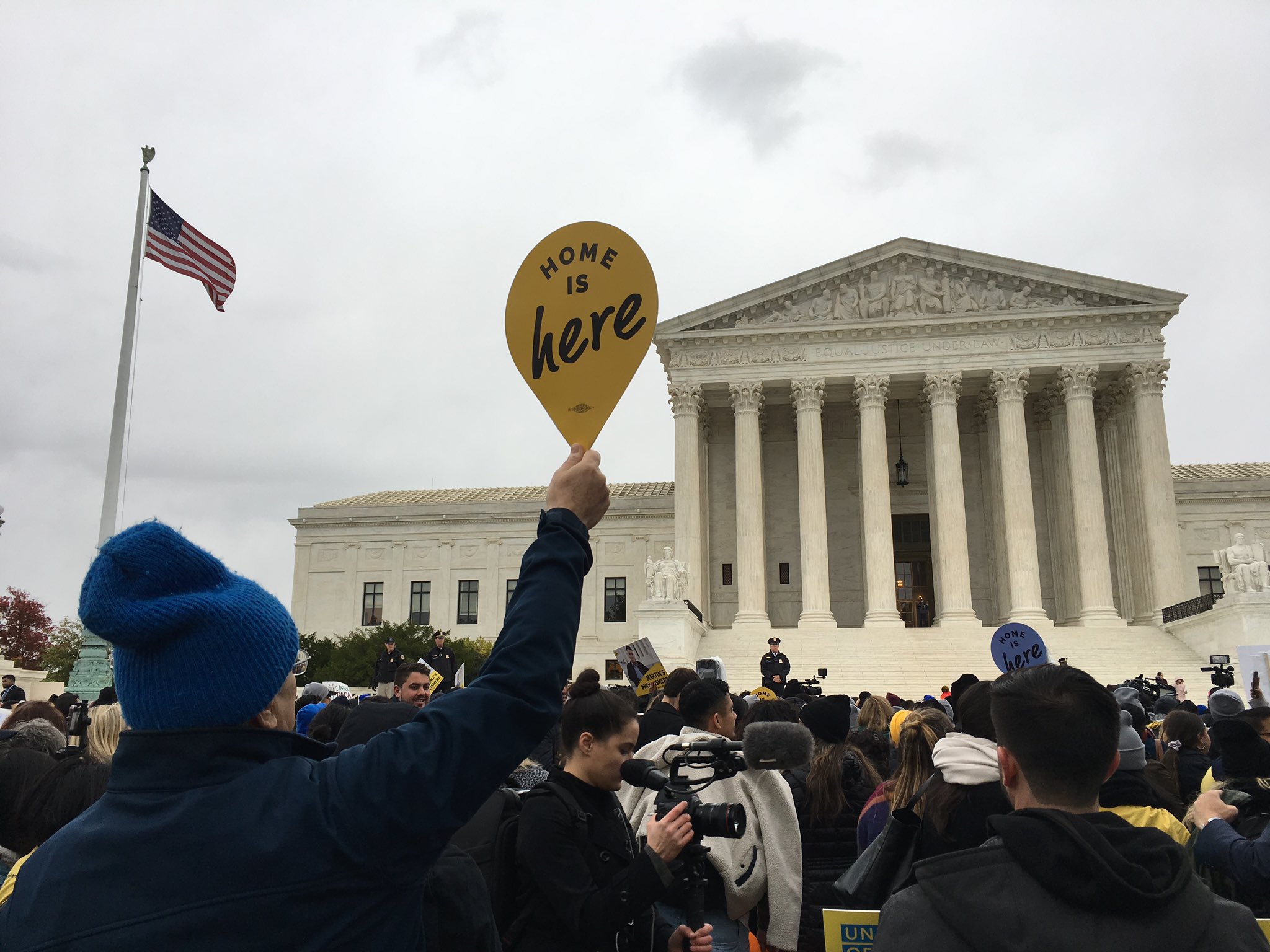
SCOTUS will soon rule on DACA in some way (photo: @afsc_org)
Scores of facebook messages and emails fill my inbox each day from immigrant youth protected under the Deferred Action for Childhood Arrivals (DACA) program — the Obama-era initiative that provided work authorization and protection against deportation for undocumented immigrants brought to the country as children.
They ask the same question: what will the U.S. Supreme Court decide on DACA.
Any day now, the nine justices will answer this question that will decide the fate of 650,000 young people shielded under the program, with an estimated 30,000 in New York City. Before we turn to the potential outcomes, however, let’s first lay out what the Court is actually ruling on.
The Court is focusing on two questions in Trump v. Regents of the University of California et al. (the DACA case): whether the Court has authority to review President Trump’s decision to end DACA, and, if so, whether he followed proper procedures in terminating DACA.
The legal path the Court takes to reach its conclusion will be as important as what it ultimately concludes. Every footnote, word, and punctuation will be critical. There is, however, legal guidance that projects three potential outcomes:
SCOTUS: We don’t have authority over Trump’s decision to terminate DACA.
This means that a President has almost full control over DACA. The worst, and unlikely, scenario here would see the United States Citizenship and Immigration Services (USCIS) dismantling the program by immediately cancelling existing work permits and invalidating pending renewals.
Depending on any arrests or criminal record, Immigration Customs and Enforcement could detain and begin deportation proceedings against the person who is no longer protected by DACA.
Control over DACA could also mean that President Trump would use it as leverage for legislative bargaining. He would likely direct USCIS to continue work permits and deportation relief until he bargains with Congress for a deal, e.g. border wall in exchange for some form of legal status for Dreamers. Anything is possible in an election year.
Another scenario under this decision would also allow a potential Biden administration to reinstate DACA — maybe even create a broader DACA program that would allow international travel and facilitate a path to citizenship.
SCOTUS: We have authority and Trump’s decision to terminate DACA is unlawful.
Under this better scenario, the Administration would need to restart the entire program. Depending on what precisely the Court considers the “lawful way,” Trump could then correctly proceed — like following the steps of the Federal Administrative Procedure Act — to end the program.
According to the Government Accountability Office, the average time a federal agency takes to change agency rules is about four years. In the meantime, USCIS could allow renewals, new applications, and even foreign travel.
If the ruling is that the President lawfully ended the program, then the Court will revert discretion to the President on how and when it can end the program. The Court could place restrictions like allowing work permits to continue until they expire or at another stated expiration date (e.g. end of the national state of emergency due to COVID-19).
DACA is itself unlawful
Finally, if the Court concludes that DACA itself is unlawful, then the program will be terminated without the President taking further steps. Once again the Court could indicate how and when the program will be rolled back.
Living at the fault line of immigration policy has filled the lives of thousands of immigrant youth with uncertainty. I know how that feels. Still, having come out of the shadows, I know that Dreamers will not go back.
Their home is here. And they are here to stay.
****
Cesar Vargas is New York's first undocumented attorney and a national advocate for immigration reform. On Twitter @Dreamer_Esq.
***
Have an op-ed idea or submission for Gotham Gazette? Email This email address is being protected from spambots. You need JavaScript enabled to view it.
As Courts Reopen, Threat of ICE Returns: State Lawmakers Must Protect Our Neighbors
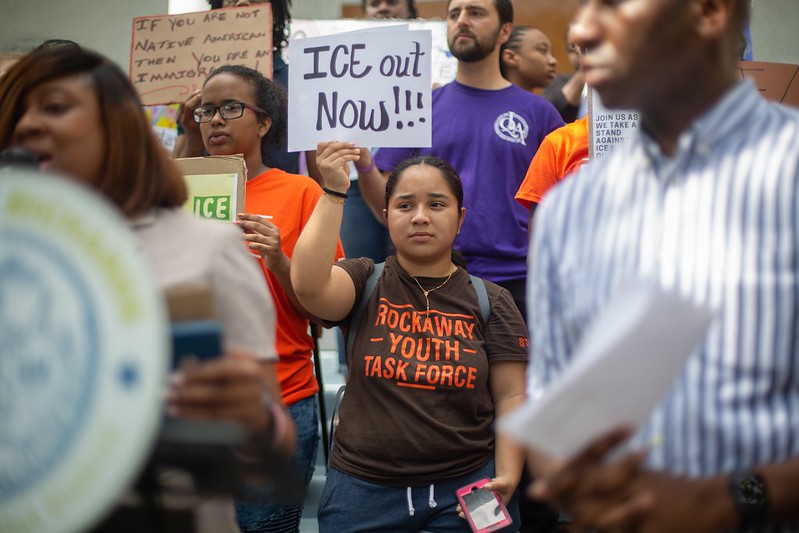
As courts in NY reopen, the role of ICE will be top of mind for many (photo: John McCarten/City Council)
Courthouses in 30 upstate New York counties have begun the gradual process of restarting the state’s legal system. The pandemic has highlighted the urgent need for due process and just how critical access to justice is for New York’s most vulnerable communities. There remain, however, significant barriers for many who desperately need their day in court.
For years, ICE has preyed on non-citizens in and around our courthouses, using fear and intimidation to limit access to justice for our communities. The Protect Our Courts Act would help ensure that all New Yorkers feel safe to access the courts by preventing ICE agents from detaining people in or around courthouses unless they have a signed judicial warrant.
Lawmakers in Albany must make the Protect Our Courts Act a priority if we are going to make the promise of equal justice under the law a reality in this time of crisis. Without this vital protection, we are likely to see a surge in ICE arrests that will effectively shut many of the most vulnerable New Yorkers out of the courts and heighten the risk of contagion for those detained. The Immigrant Defense Project (IDP) tracks ICE raids throughout the state, and in the first 11 weeks of 2020, raids in New York City increased 400% compared with the same period last year. When these arrests ramp up again, and they will, the same communities hardest hit by COVID-19 will have to endure another wave of attacks, mourning, and lives disappeared.
ICE has already used the courthouse to trap immigrants during the current crisis. On March 13, as President Trump declared a National Emergency, Mr. RC, a client of The Bronx Defenders, appeared in state court in Poughkeepsie. Despite the mounting pandemic and the deployment of state and federal resources to try to contain the virus and protect public health, six ICE officers entered the courthouse, defying Office of Court Administration rules promulgated last year, waited for Mr. RC outside the courtroom doors, and arrested him as he left his court appearance. None of the officers wore gloves, masks, or any other protective gear. ICE then detained Mr. RC at the Orange County Jail, increasing the likelihood of exposure and separating him from his fiancee and one-year-old as the worst period of the pandemic was just beginning.
Mr. RC’s experience is not an aberration. The Bronx Defenders has represented hundreds of individuals arrested under circumstances that demonstrate ICE’s disregard for the health, safety, and, indeed, the humanity of immigrants in New York. The tremendous health risks posed by detention centers have been well-documented. Detained immigrants have been holding hunger strikes, protesting, and filing lawsuits calling on ICE to end unnecessary and harmful detention. The last place anyone should be in the midst of this pandemic is a cage. At this critical moment, New York should embrace legislation that would limit ICE’s ability to pull more New Yorkers into its dragnet.
It is hard to imagine a worse time to punish and endanger immigrant New Yorkers. Every ICE arrest, detention, and deportation takes someone away from communities that have been pushed past the breaking point. The death rate for black and Latino people in New York City has been twice the rate for white people, and essential workers most at risk are disproportionately likely to be women, immigrants, black, and Latino. As people vanish from the neighborhood, loved ones are left turning over survival and grief in their hands as refrigerated trucks full of the deceased sit in parking lots nearby.
The Protect our Courts Act already has majority support in both chambers of the New York State Legislature. Now more than ever we cannot let ICE stand in the way of full access to public services, rights, and remedies, including those available at the courts, such as orders of protection, fighting evictions, seeking child support, and defending oneself against criminal charges. When ICE’s intentions to use our courts as a lure to detain immigrants at the outset of a pandemic are so clear, we must not wait to see how ICE will strike next before we act.
***
Mizue Aizeki is the deputy director of the Immigrant Defense Project. Rosa Cohen-Cruz is the Policy Counsel to the Immigration Practice of the Bronx Defenders. On Twitter @ImmDefense & @BronxDefenders.
***
Have an op-ed idea or submission for Gotham Gazette? Email This email address is being protected from spambots. You need JavaScript enabled to view it.
Trump Continues His Assault on Independent Oversight and Rule of Law
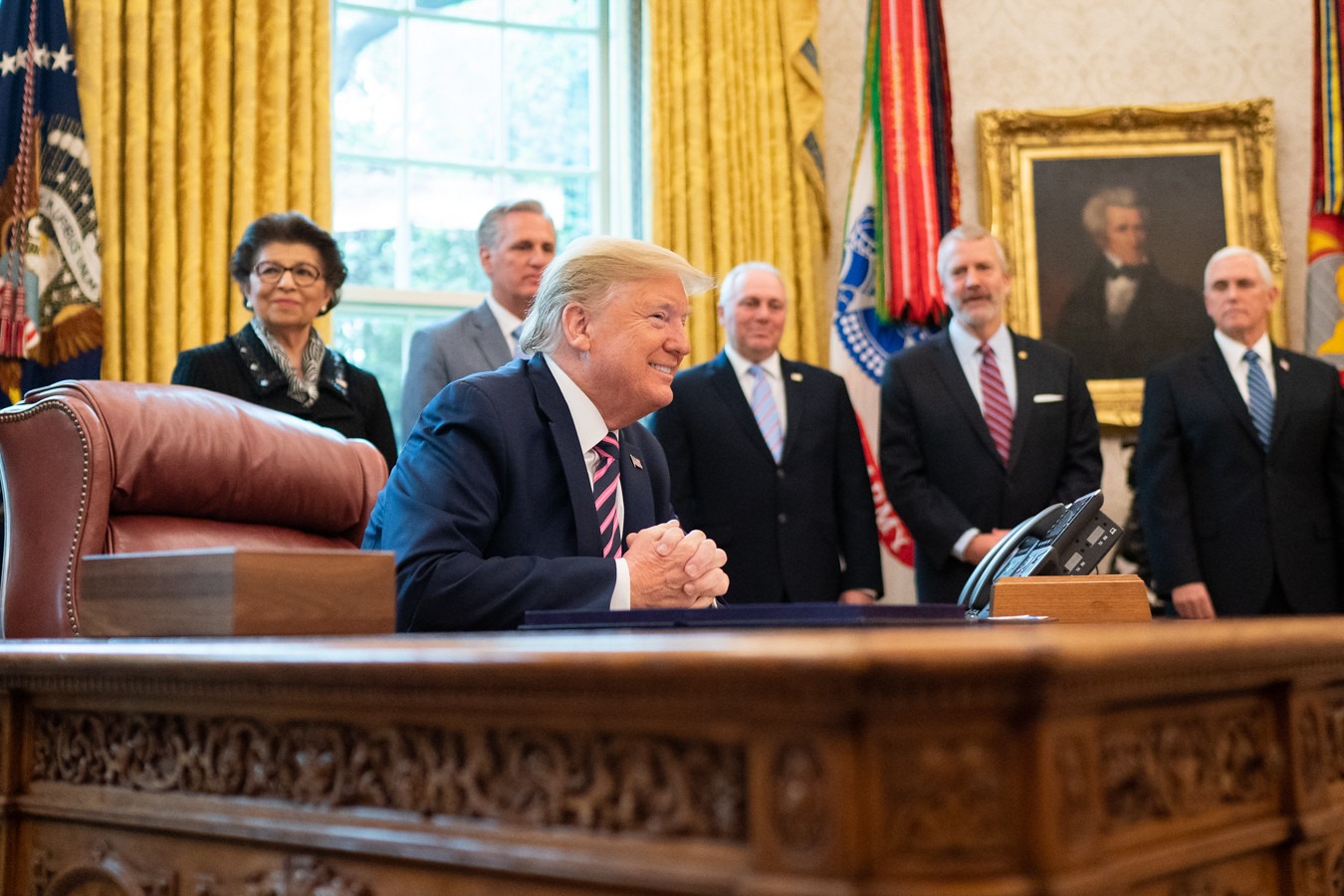
President Trump (photo: White House)
In late April, I wrote a guest column regarding President Donald Trump’s firing of a federal Inspector General, threats to other IGs and the rule of law, and how New York City’s inspectors general system is a model, with no city IG removed for doing their job. Over the last weeks Trump has escalated his war on the nation’s watchdogs as a way of “draining the swamp,” or, in reality, removing independent oversight of him and his administration.
The following is an update of Trump’s attack on the independence and integrity of IGs after unsupported firings of three inspectors general and a political juggling act removing another IG. A total of four federal IGs are gone, one of which Trump first chastised before firing. Now, all federal IGs must be looking over their shoulders at a lurking president.
The mission of all inspectors general is to provide independent, objective oversight to improve the integrity, accountability, and performance of our government and to improve government programs, in part by recommending corrective actions and promoting high standards.
The 1978 Inspector General Act, supported by six Democratic and Republican presidents, mandates the importance of independent oversight. Since April 3 President Donald Trump did a spring IG housecleaning, ending independent oversight with retaliatory firings of three IGs after publicly flogging one and replacing another.
All four IGs felt Trump’s wrath while protecting our nation. An abuse of presidential power unheard of in 42 years, now rocking our government to the core with threats and suppression of our nation’s watchdogs from ferreting out waste, cronyism, fraud, and corruption. It is an egregious assault on good government, integrity and independence, especially after Congress appropriated trillions to fight a pandemic.
On May 15, State Department Inspector General Steve Linick was fired. Linick was reportedly investigating Secretary of State Mike Pompeo for having a State political appointee perform personal tasks for Pompeo and his wife. (In New York City, that’s a violation of the City Charter.)
Additionally, at Congress’ request, Linick was investigating an $8 billion arms deal, bypassing Congressional review, with Saudi Arabia.
These two investigations were halted by Trump’s unfounded firing, as urged by Pompeo, the target of the IG’s investigation. Pompeo said of Linick’s termination, “Frankly, should've done it some time ago.” Trump ratified this manipulation, incredibly saying, "Never even heard of Linick," but fired him because Pompeo “asked me to terminate him” and Linick “no longer had my full confidence.”
This is not the first time Trump used the ridiculous 'never heard of him' response when he himself was linked to wrongdoing and clearly knew the individual involved.
For instance: Lev Parness, Rudy Giuliani’s crony tied to the Ukraine scandal; Gordon Sondland, Ambassador to the European Union, a major donor to the Trump inauguration committee and a key impeachment witness; and sex trafficking kingpin Jeffrey Epstein; among others.
In an obvious move to protect Pompeo and derail Linick’s investigations, Trump named Stephen Akard, an ambassador closely aligned to Vice President Mike Pence, as Linick’s IG replacement. It’s unclear how well Trump knows Akard.
Although Linick is the latest to be axed, the IG massacre started on April 3 with the firing of Trump’s own appointee, Michael Atkinson, who was Inspector General at the Office of the Director of National Intelligence, for disloyalty. Atkinson, investigated the whistleblower’s complaint alleging Trump pressured the Ukraine president to investigate presidential candidate Joe Biden’s son. Atkinson was fired for doing his job and not revealing the whistleblower’s identity.
Next was Christi Grimm, Health and Human Services’ Deputy Inspector General, who reported coronavirus shortages and testing delays at our nation’s hospitals. Trump loudly criticized Grimm, calling the IG’s report “fake” and insinuating, without support, Grimm’s report was politically motivated. Trump fired her.
Then there is Glenn Fine, the Department of Defense’s acting Inspector General, who was selected by a Council of IGs, based upon Fine’s credentials and DOD title, to serve as Congress’ coronavirus special IG, wisely established by Congress in the $2.2 trillion CARES Act to ensure funds are not misspent for coronavirus relief efforts. Evidently, alarm bells went off at the White House with this oversight temporarily vested in a special IG not appointed by the president.
Corrective action was required.
In a deft sleight of hand in the middle of the pandemic, Trump removed acting DoD IG Fine and replaced him with Sean O’Donnell, making O’Donnell the Council’s selection as the temporary coronavirus special IG since the appointment was tied to the DoD post, not the person. Additionally, O’Donnell continues to serve in two acting positions as Trump’s EPA IG and DoD IG.
Trump nominated Brian Miller as the permanent special inspector general for pandemic response – replacing O’Donnell – and the Republican majority Senate committee voted 14-11, recommending Miller’s confirmation to the full Senate.
Independence was the key watchword at Miller’s Senate confirmation hearing. Trump’s pick, currently a White House lawyer and formerly one of Trump's impeachment attorneys, loudly raised a number of Democratic senators’ voices, notwithstanding Miller, as Linick, Fine and Grimm, served in both Democratic and Republican administrations as a federal watchdog.
Miller promised the senators he wouldn’t “bend” for anyone in Trump’s orbit if confirmed. The Democratic senators were doubtful, as they and we should be.
Notwithstanding this whirlwind presidential power game of IG musical chairs, the burning question is: will Trump loyalists O’Donnell and Miller (once the Senate confirms him) aggressively investigate whether the coronavirus trillions are properly spent?
If they do, O’Donnell will be out of his acting Trump jobs, and for Miller, private practice looms.
What is critically at stake with Trump's political firings is the independence of inspectors general, which Trump ended by breaching the Act's clear intent.
Checking and balancing a presidential abuse of power rests with the Congress. Miller’s Senate confirmation must be used as the means to raise the issue of how to protect IGs from reprisals by a disgruntled and circling president. Unfortunately, politics will prevail, and Miller and other Trump IGs will be confirmed with no safeguards enacted.
Result: good government will suffer deeply -- it already has.
***
Arnold N. Kriss is an attorney in private practice, and a former NYPD Deputy Commissioner for Trials and Brooklyn Assistant District Attorney. On Twitter @ArnieKriss.
***
Have an op-ed idea or submission for Gotham Gazette? Email This email address is being protected from spambots. You need JavaScript enabled to view it.
I Survived COVID-19; It Proved the Queens Hospital Crisis
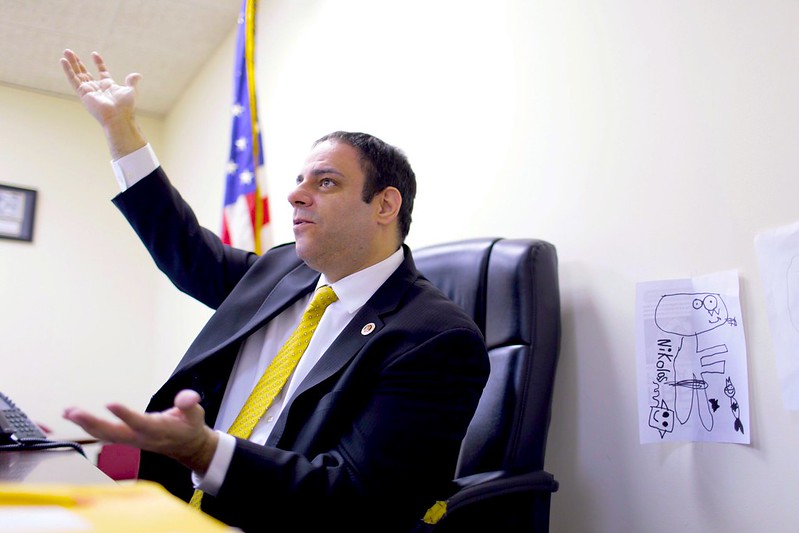
Council Member Costa Constantinides (photo: New York City Council)
The whole thing happened so fast. One minute my son and I are playing video games and the next he and my wife, who struggles with diabetes and is in renal failure, rush out the door to her mother’s apartment. So much has changed for my family and our community in the weeks since my fever first hit 102 degrees. However, throughout this experience, one thing remains shockingly clear: we need more hospitals in Queens and to reimagine how people access health care in the World’s Borough.
Queens is the epicenter of the epicenter. All of us — from those who fell ill, to our healthcare workers, to those whose anxiety was worsened by being locked in for weeks — will no doubt carry physical and mental scars forever. My family’s hellish few weeks of multiple trips to the hospital is the story of so many residents of Queens, where well over 56,000 positive cases are among the most of any county in New York State. And in many ways my wife and I are lucky.
Still, I’ll admit it’s been hard not to be angry at the fact that Queens has lost five hospitals over the last 20 years. You cannot refute that the loss of hundreds of hospital beds over a two-year period in the late 2000s is part of the reason why so many people have died — many at home surrounded by panicked relatives unsure of what to do. About one-sixth of all New York State’s positive COVID-19 cases have been in Queens, a borough of 2.3 million people serviced by eight hospitals. It doesn’t take a math expert to see this was a doomed situation from the get-go. Because we didn’t have a plan sooner to flatter the curve, a tidal wave crashed down on our already worn-out health-care system -- and we couldn’t even brace for it.
This virus is an enigma even the world’s most brilliant minds are still working to crack. Not understanding the symptoms has led many of us to overthink every cough. Panic reigned supreme. Was I cold because the fever is back or because the window was open? Do I have to go to the hospital for burning my hand on the radiator, potentially spreading this to more people? Why did I feel better one day and twice as worse the next? It took weeks to accept the fact that I cannot unpack this problem, determine the cause, and find a creative solution. I could not legislate away the coronavirus.
The best I can do is to get better, then work like hell to make sure other people can solve this. Once we’re fully on the other side of this curve the first order of business must be to build new hospitals in Queens. We lacked the capacity to properly observe all COVID-19 patients, let alone treat any other illnesses or injuries people experienced during the apex. The isolation of this virus is the cruelest part, as it takes away the support system on which we all rely. Many sat at home like I did, frightened by their symptoms, left to stare at their son’s toys on the floor or their wedding photo on the wall and wonder, Will I ever see my family again?
New hospitals shouldn’t be just about saving the lives of people who walk into them. It’s about those who run them, too. Our health-care workers are heroes, but they’ve also borne the burden of a pared down medical system. They work tiring shifts without enough protective equipment. Because we cannot hold our loved ones’ hands as they succumb to this virus, these heroes provide those last moments of comfort. Many are stoics who shrug it off as “part of the job,” but we know they are silently fighting severe emotional distress. A memorial to them is overdue. But the greatest tribute we can make is to build the infrastructure, both in more capacity so they can do their best job possible the next time a pandemic strikes and in support so they won’t be coming home to deal with tragedy alone.
I first ran for office seven years ago on the promise to support Mount Sinai Queens, which in 2004 didn’t have the specialized resources to treat my father for an aneurysm. He died in transit to the closest Manhattan hospital that could. My hope was that no one would have to face the choice I did: let him die here in Queens or run the risk of crossing the bridge. I thought it was a major victory when we funded a state-of-the-art stroke center there. I've been proud to support and partner on this vision of growth at Mt. Sinai. In hindsight, however, it was a drop in the bucket. So much more is needed now.
Everyone should have the ability to go to a hospital. The hard work to get out of this crisis has only begun. It will be all for nothing unless we fight for greater hospital capacity. I owe it to the countless people who made sure our son still has his mom and dad.
***
Costa Constantinides is a New York City Council Member and candidate for Queens Borough President. On Twitter @Costa4NY.
***
Have an op-ed idea or submission for Gotham Gazette? Email This email address is being protected from spambots. You need JavaScript enabled to view it.




